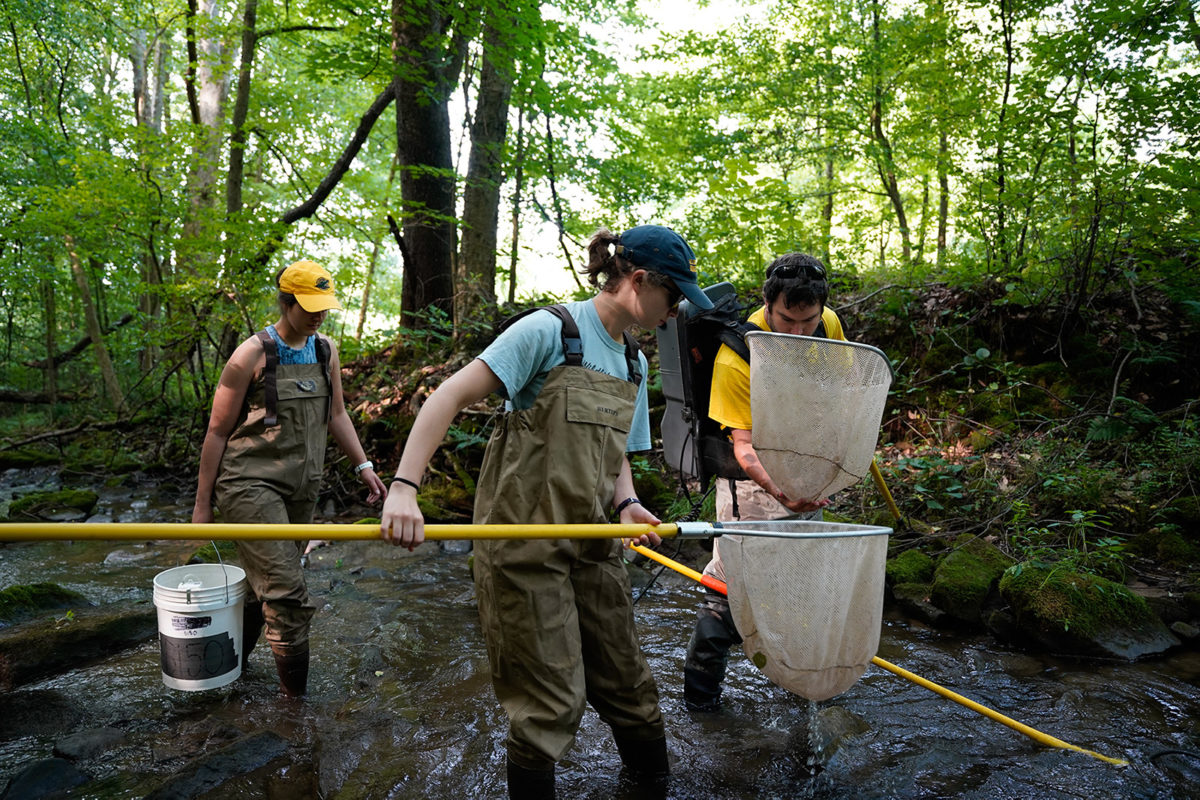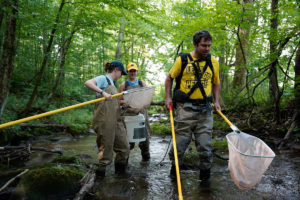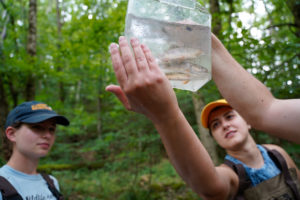
Following the Fish
Allegheny College Research Team Helps Statewide Effort in Stream Monitoring and Trout Assessment
Two Allegheny students and an alumnus of the College have been working this summer in little-known streams in the area helping the Pennsylvania Fish & Boat Commission (PFBC) monitor water quality and document the presence of valuable trout and other aquatic life.
Rising seniors Grace Hemmelgarn from Williston, Vermont, and Danielle Studer from Austinburg, Ohio, have been electrofishing in the streams with Dr. Mark A. Kirk, a 2011 Allegheny graduate and currently a Murray State postdoctoral research associate.

“We go out and electrofish the streams and record what we find. We also do some habitat assessments and water chemistry measurements,” said Hemmelgarn, an environmental science and sustainability major and a Spanish minor.
“Danielle and Grace get the opportunity to assist in fisheries research by learning common fisheries practices, such as backpack electrofishing and water chemistry analysis,” said Kirk. “These experiences will benefit them during their senior thesis projects at Allegheny and their career development after Allegheny.”
(Electrofishing is a common scientific survey method used to sample fish populations to determine abundance, density, and species composition. When performed correctly, electrofishing results in no permanent harm to fish, which return to their natural state in as little as two minutes after being caught.)
At the end of the summer research, the Allegheny team will provide a complete inventory of fish communities in at least 20 small streams in a region of northwest Pennsylvania that is celebrated for its overall fish biodiversity, but for which the presence of native brook trout have not yet been surveyed, said Kirk. This will result in about 2.5 miles of newly assessed streams for the PFBC, he said.
The research team has been part of the state commission’s Unassessed Waters Initiative. Since its inception in 2010, the Unassessed Waters Initiative has grown tremendously. From 2011 to 2017 (which is the last year of updated information), PFBC and their partners have assessed 5,932 streams across the state with 12,410 miles of streams surveyed. On average, about 600 streams are sampled annually and about 40 percent of those streams end up being undocumented wild trout streams. Colleges and universities serve as the primary partner for PFBC in this program.

Kirk conducted his undergraduate research at Allegheny on aquatic ecology and fisheries ecology with former Professor Scott Wissinger, who passed away in 2019. Kirk earned his master’s degree from the University of Idaho and his Ph.D. from the University of Wyoming. “During that time, I kept an ongoing, long-term collaboration with Scott Wissinger on the Unassessed Waters Initiative and other aquatic ecology projects at Allegheny,” he said.
This summer, the PFBC asked the Allegheny researchers, under the guidance of Casey Bradshaw-Wilson, assistant professor of environmental science and sustainability, to focus on tributaries of the Little Shenango River near Greenville and tributaries of the West Branch of French Creek near Wattsburg. “Our primary focus has always been on streams in the French Creek watershed. The Little Shenango River has not been sampled by us before, and it has been undersampled in recent years for wild trout populations, making it a high priority area,” said Kirk.
By mid-July, the group had documented no wild trout populations in the Little Shenango River basin, Kirk said. “Although PFBC annually stocks brown trout in the Little Shenango, no wild reproduction has been observed by us,” he said. “Many of the tributaries we have sampled in the Little Shenango are muddy, silt-bottom streams, which do not have good habitat for brook trout and brown trout. Hence, the lack of wild trout is likely due to a lack of quality trout habitat.”
Kirk added that the researchers will acquire information on the land-use and reach-scale habitat characteristics for the streams, allowing them to infer how land use affects fish community characteristics and the presence/absence of trout populations.
“The unassessed waters project has given me hands-on experience with local ecosystems and provided me with an important mentor in fisheries biology,” said Hemmelgarn. “I have learned about electrofishing, water chemistry, and stream habitats while improving my native fish identification skills. This project has helped me expand my scientific thinking to an ecosystem level while providing me with valuable skills and experience for my senior thesis, grad school, and beyond.”
Grant funding was made possible through the Foundation for Pennsylvania Watersheds (FPW), and is intended to support the Unassessed Waters Program, which works to identify trout waters throughout Pennsylvania. FPW is a nonprofit, grant-making organization supporting water-quality needs throughout Pennsylvania.